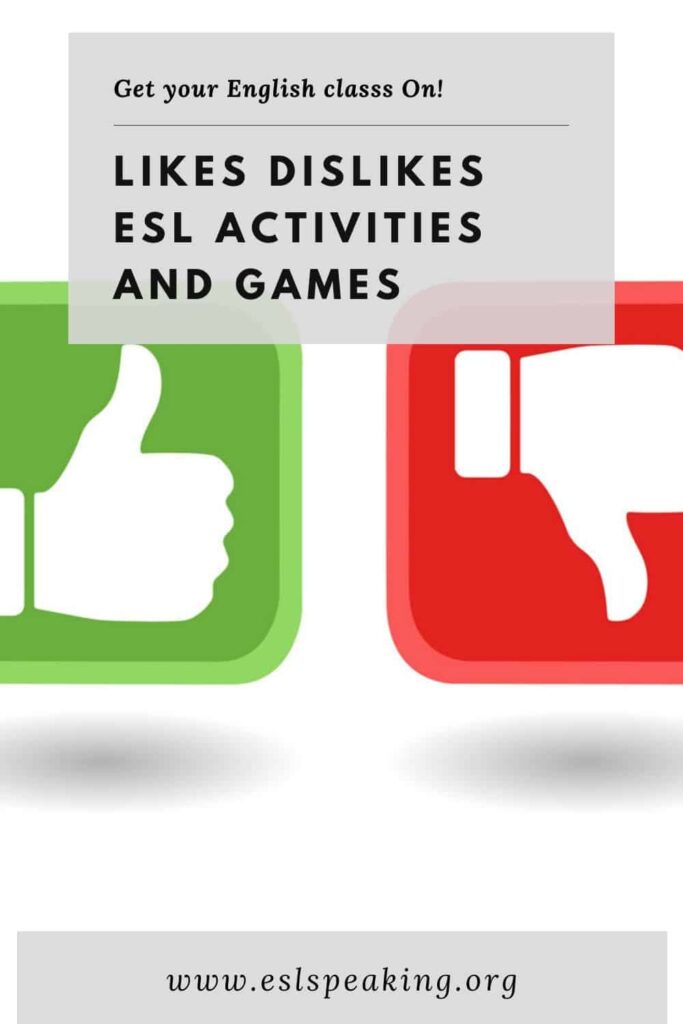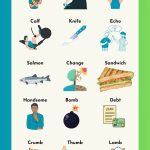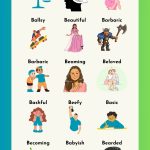If you’re looking for some of the best likes and dislikes games and activities for ESL/EFL classes, then you’re certainly in the right place. We’ll have lots of those, along with likes dislikes worksheets, lesson plans, questionnaires and more. Keep on reading for all the details you need to know about likes vs. dislikes TEFL activities.

Likes and dislikes ESL Games
Likes Dislikes ESL Activities and Games for All Ages
Let’s get into the best like dislike ESL games and activities. Expressions likes and dislikes is an important skill in functional English.
#1: Likes/Dislikes Surveys
I love to use surveys in my classes—just ask my students and they’ll tell you the same. They’re ideal for ESL/EFL classes because they cover a range of skills, get the students interacting with others and also the fact that they lend themselves well to a variety of topics.
Of course, they are perfect for the unit on likes and dislikes. Find out more about how to design your own here:
#2: Do you Like to _____?
This is a simple but fun ESL activity that requires nothing in the way of preparation or materials and is perfect for likes or dislikes.
The way it works is that students write down some things they like or don’t like on strips of paper. Then the teacher collects them all and distributes them around the class. Students have to mingle, asking questions in English to find their matches. Find out how to do this activity here:
Do you like to ______? ESL Activity
- Amazon Kindle Edition
- Smith, Jennifer Booker (Author)
- English (Publication Language)
- 134 Pages - 03/31/2016 (Publication Date)
#3: Telephone Speaking Game
One of the most fun ESL speaking games is telephone. I’m sure you remember playing it as a kid. The way it works is that students get into teams of 5-10 students in a single line. Then, the teacher gives the first students a sentence and they have to pass it down the line. The last student compares what they have with the original one. The results? Usually hilarious!
In this case, start with a sentence like the following:
- I like banana, watermelon and peach ice cream but I don’t like asparagus, pepperoni pizza or blue cheese.
Find out more about how to play this game here:
#4: Like and Dislike Board Game
I love to play board games so it makes sense that I get my students to play them as well! With a little bit of practice, it’s super easy to design your own in just a few minutes. In this case, you’d want to fill the board with plenty of like/dislike questions. For example:
- What’s something you liked as a kid but don’t like now?
- What kind of foods do you like?
- Where do you like to eat out?
- What kind of food do you hate?
Find out all the details about how to make your own TEFL board games here:
#5: Likes Dislikes Songs and Chants
If you teach kids, then you’ll certainly want to use some songs and chants in your classes. It’s a fun way to introduce new vocabulary and reinforce key grammar points. If you’re not musical, not to worry! There are lots of excellent options on YouTube.
#6: Flashcard Sentences
In my opinion, flashcards are one of the most under-utilized ESL teaching resources. For kids, I almost never set foot in a classroom without them!
In this case, a super-simple speaking activity you can do it to hold up a flashcard to a student. They can say whether or not they like that thing. For example:
- I like bananas.
- I don’t like apples.
Of course, there are lots of other things you can do with them too. Here are some more ideas:
#7: ESL Role-Plays
If you ask students what they want to work on in class, they’ll often say conversation or speaking. However, this can be a little bit difficult for beginners because they often lack the vocabulary and grammar to be able to speak freely.
One way to bridge the gap is with role-plays because they offer some structure. However, they also offer some freedom for students to complete the conversation as they wish. In this case, the conversation could be something about likes/dislikes. For example, a conversation about where two students would like to eat lunch together. Find out more details here:
#8: Rock-Scissor-Paper
An ESL game that you might want to consider to work on likes vs dislikes is this easy one. The way it works is that you make a bunch of questions/answers related to likes or dislikes. Then, cut them up into strips of paper and distribute them around the class.
The students have to mingle with each other to find their matches. When they do, they so rock-scissor-paper and the winner takes both papers. Want to give it a try? Find out more here:
ESL Rock Scissor Paper ESL Speaking Activity.
#9: ESL Food and Drink Activities
Food is one of those areas that people have both strong likes and strong dislikes. That’s what makes this context ideal for teaching this vocabulary point. Here are some of my top ideas:
#10: ESL Clothes and Fashion Games and Activities
Clothes are certainly a matter of personal taste and probably no two people are exactly the same. It’s a nice context in which to talk about likes and dislikes. The good news is that there are so many engaging, interesting things to do with this unit. Here are some of them:
#11: Conjunction Activities
A nice way to introduce conjunctions (and/but/or/so) is in the context of likes and dislikes. For example:
- I love vegetables but I don’t like fruit.
- My sisters likes soccer, swimming and tennis.
- My Dad doesn’t like his job so he leaves as soon as possible after work is done.
For some of the best activity ideas, you’ll want to check this out: ESL Conjunctions.
#12: Fruit and Veggies ESL Quiz
Fruits and vegetables are some of those things that people have strong likes and dislikes about. Check out this simple online quiz:
#13: ESL Running Dictation Game
One of the most versatile ESL games is running dictation. It covers all four skills in a single activity, gets students out of their seats and having fun and best of all, can be used for any topic or grammar point.
In this case, you’ll need to find a conversation filled with examples of likes and dislikes. The textbook you’re using in class may be a good source for this. Learn more about this like and dislike game here:
#14: Dialogue Substitution
Have you ever noticed that many grammar and vocabulary concepts are introduced through a dialogue in ESL textbooks? But, it’s probably also the case that your students are kind of like mine and just blow through them without really paying attention to what they’re reading.
Of course, it’s not the students’ fault—it’s just that we haven’t given them a reason to slow down and pay attention to what they’re reading. A way to combat this is the remove so of the words and students have to read as well as fill in the blanks. In this case, remove things related to likes and dislikes. Find out more details here:
ESL Dialogue Substitution Activity.
#15: WH Question Games and Activities
W and H questions lend themselves particularly well to likes and dislikes. For some of the best ideas for activities and games to use with your students for who/what/when/why/where/how questions, you’ll want to check out the following:
#16: More Ideas for ESL Speaking
#17: Just a Minute
An easy speaking activity that’s perfect for likes and dislikes is Just a Minute. It’s challenging and best for high-intermediate or advanced level students.
The way it works is that each student has to speak for 1 minute without stopping about a certain topic. For example, foods they like or dislike. Or, their style and what kinds of things they like to wear. Check it out for yourself:
Just a Minute ESL Speaking Activity.
#18: Just One Question
This is a survey activity that’s perfect for likes and dislikes. The way it works is that in pairs, students have to ask their classmates one interesting question, compile the results and then report them to the class. It requires a range of skills and some serious teamwork. Learn how to try it with your students:
Just One Question Survey Activity.
#19: Disappearing Text
A nice option for reviewing sentence construction for likes/dislikes is disappearing text. Write a sentence on the board and students have to say it out loud. Then, erase the words one by one and students will eventually say the sentence but there will be nothing left. Find out all the details:
Disappearing Text Review Activity.
#20: Odd One Out
#21: Me Too! ESL Speaking Activity
This is a simple speaking activity that’s perfect for reviewing likes/dislikes. The way it works is that students have to make a statement about something they like or don’t like. If another student had the same opinion, they have to stand up and say, “Me too!” Here’s more information about it:
Me Too! ESL Speaking Activity.
#22: Discussion Starters Likes and Dislikes
If you tell students to talk with a partner about things like and don’t like for a certain period of time, you may be met with silence! The better way is to give some direction and discussion starter questions. They are something concrete for students to grasp onto if they get stuck and aren’t sure what to say. Here are some of the top picks:
Discussion Starters for English Learners.
#23: Dictation
#24: Dictogloss with Likes and Dislikes Examples
If you teach more advanced-level students, try out this challenging listening activity. Find, or write a passage with someone talking about things that they like and don’t like.
Then, put students into pairs and read out the passage at a faster than normal pace for the level of the students. The students have to take notes and compare them with a partner to try to recreate what they just heard. Repeat the process again. In the end, students compare their version with the teacher’s version. Check it out:
#25: Memory Circle
This is a nice review activity for talking about things people like or dislike. Students can say a sentence with something they like or don’t like. Then, the next student has to repeat that one and then add their own. The game continues until people can’t remember and one person is left standing. Learn more about it:
#26: Like and Dislike Vocabulary Auction
This is a fun sentence building activity that works very well with like/dislikes. Make up a bunch of sentences using the target vocabulary. Then, cut each word up and mix them up.
In groups, students bid on words that they think will help them make complete sentences. After bidding, there is a trading session. Finally, the winner is the group with the most complete sentences.
It does take a bit of preparation time to do it, but it’s totally worth it! Students love this activity. Find out more:
#27: How do you Play Likes and Dislikes?
Here’s a simple game that you can play in class, likes and dislikes. It works best for smaller classes. Each student writes down three things that they like and three things that they don’t like on a piece of paper.
The teacher collects the papers and then reads out the likes dislikes. The students in the class have to try to guess who it is.
#28: Would You Rather Questions
Would you rather questions are the ultimate way to express likes and dislikes. Check out a great resource here:
- Amazon Kindle Edition
- Bolen, Jackie (Author)
- English (Publication Language)
- 81 Pages - 12/19/2022 (Publication Date)
#29: Postcards Writing Activity
On a postcard, it’s normal to write about things you’ve liked and things you didn’t like on a vacation. Check it out here:
Likes and Dislikes Questionnaires
There are some excellent like dislike questionnaires and surveys that you can find online which are perfect for TEFL classes. Here are a few of them to consider using:
Likes Dislikes Worksheet
Why reinvent the wheel if you don’t have to? There are lots of excellent likes and dislikes worksheets online:

Like vs dislike activities
Likes and Dislikes ESL Lesson Plan
If you’re a busy English teacher, then you’ll know what a game-changer it can be to just use a lesson plan that’s already done for you. Just print it off and take it to class. There are a lot of good ones out there—here are just a few of the best ones for likes/dislikes:
Likes/Dislikes ESL FAQs
There are lots of questions that people have about teaching likes vs. dislikes. Here are the answers to some of the most common ones.
How do you teach likes and dislikes on ESL?
To teach likes and dislikes for ESL learners, draw two columns. One has a happy face while the other one has a sad face. Then, use some pictures of common food and ask students if they like, or don’t like them. Mime with facial gestures as well for liking and not liking something. Then, get students to make complete sentences. For example, “I like bananas. I don’t like kiwi.”
How do you say likes in English?
There are lots of ways to express likes in English. Some of them include:
- I love…
- I adore…
- I’m crazy about…
- I enjoy…
- I’m keen on…
How do you say dislikes in English?
There are lots of different ways to express dislikes in English. Some of them include:
- I hate…
- I detest…
- I’m hoping not to…
- I loathe…
- I try not to…
Did you like these Likes vs Dislikes Games and Activities
- Amazon Kindle Edition
- Bolen, Jackie (Author)
- English (Publication Language)
- 148 Pages - 03/09/2016 (Publication Date)
Yes? Thought so. Then you’re going to love this book over on Amazon: 101 ESL Activities for Teenagers and Adults. The key to better English classes is a wide variety of interesting and engaging games and activities and this book will help you get there in style.
The best part it that’s it well-organized into sections from speaking to writing to grammar and icebreakers so you should be able to find what you’re looking for in just a minute or two. Less time spent lesson planning? What teacher doesn’t love that!
Pick up a copy of the book to keep in your office to use as a handy reference guide. Or, consider taking the digital version with you on your tablet, phone or laptop to your favourite coffee shop for some lesson planning on the go. It’s easy with the free Kindle reading app.
Head over to Amazon to pick up a copy for yourself, but only if you want a serious dose of ESL teaching awesome in your life:
Have your Say about Likes Dislikes Games for ESL
Do you have a top pick for a likes and dislikes game or activity for ESL? Did you try out one of them from this list? Leave a comment below and let us know what you think. We’d love to hear from you.
Also be sure to give this article a share on Facebook, Pinterest or Twitter. It’ll help other busy English teachers, like yourself find this useful resource.

Likes dislikes ESL activities and games
Last update on 2024-04-25 / Affiliate links / Images from Amazon Product Advertising API








Leave a Reply